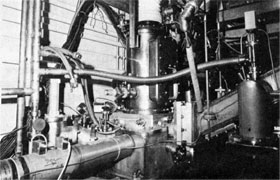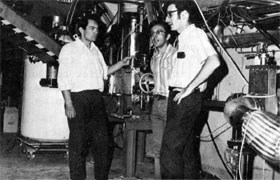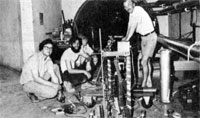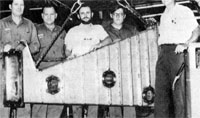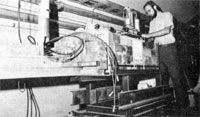Internal Target Section Experiments in Full Swing
On April 12, 1971, the "Internal Target Section" was added to the NAL working structure. With headquarters at 35 Shabbona in the NAL Village, the group was organized to assist and expedite the installation and operation of experiments that utilize the Main Ring vacuum chamber in a straight section located at position CZero (C0) on the Ring. Ten weeks later, three experiments were installed and regularly collecting data.
Headed by physicist Ernest Malamud, who was associated with the NAL Main Ring construction and operation since January of 1968, the Internal Target Section's first assignment was to aid Experiment No. 36, a collaboration of NAL, Rockefeller University, the University of Rochester, and the U.S.S.R. (See the February 10, 1972 issue of The Village Crier.) In February of 1972, the first phase of the experiment was installed utilizing a tiny rotating target of polyethylene foil built at the University of Rochester. Beginning on March 6th, data was recorded as the proton beam struck this target. The number of protons bouncing off the target at different angles revealed the extent and characteristics of the forces between the protons. The experiment revealed how the radius of the proton varies with the energy of the beam.
An exciting new phase of Experiment 36 began when installation of a hydrogen gas target was completed. The assembly and installation followed more than a year of weekly communications by teletype between NAL and scientists from the Soviet Union who had originated the technique of using a narrow band of tiny hydrogen ice crystals as a target for the proton beam. In regular Thursday morning teletype talks, the Soviets and NAL staff members made plans for the collaboration which provided that the jet would be built in the Dubna machine shop, brought to NAL, and joined with a vacuum box, alpha particle calibration source, rotating foil target built in the United States.
The Soviet group of seven scientists and their wives arrived for a one-year visit in the U.S. on March 5th, 1972. They brought the completed jet target, controls, electronics and detectors with them. They arrived in time to join the NAL staff on March 8th celebrating the reaching of 200 BeV design energy. The succeeding weeks saw the gradual fulfillment of the cooperative venture as Russian and American equipment was connected together.
Members of the Russian group were - Victor Bartenev, Anatole Kuznetsov, Boris Morozov, Vladimir Nikitin, Yuri Pilipenko, Vladimir Popov, and Leonid Zolin.
By May 20th, the assembly and testing of the target began to yield successful results. Test runs on May 25th and June 10th were also satisfactory. In a massive 4-day effort beginning June 26th, the target was moved from the Village and installed in its final position in the Main Ring tunnel. By June 28th, the helium transfer line, approximately 100 feet long, running from the liquifier on the ground level down to the tunnel was also completed. Liquid helium started filling the dewar in the tunnel on the evening of June 29th.
Experiment 36 started operation of its second phase immediately. The group had already logged 318 hours of "target in" time with their foil target. About 12 million events were collected at 80 BeV and 23 million at 200 BeV.
Experiment No. 120 also shared the target measuring gamma rays. The experiment involved scientists from Harvard University and the University of Wisconsin.
Another group -Experiment No. 67 - which includes physicists from Rutgers University, Upsala College, and Mississippi State University, studied the protons recoiling off this target to learn about resonance structure of the proton.
NAL staff members of the Internal Target Section included: Jim Klen, Ernest Malamud, Joel Misek, Don Mizicko, Chuck Nila, Wally Pelczarski, Barb Perington, Ed Podschweit, Tom Rathbun, Buzz Rodewalt, Bruce Strauss, Dave Sutter, Ryuji Yamada. Bill Carter ran the staff shop used by the Internal Target and Proton Lab Sections. Jim Batek, Sharon Fleming and Verence Moore joined the section for the summer months.



